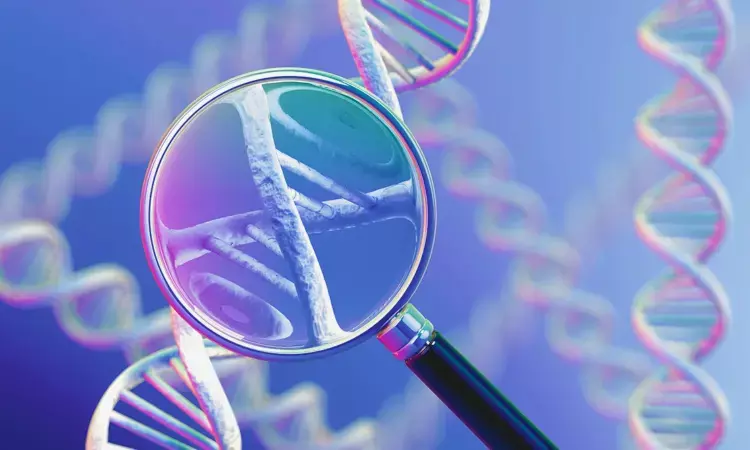- Home
- Medical news & Guidelines
- Anesthesiology
- Cardiology and CTVS
- Critical Care
- Dentistry
- Dermatology
- Diabetes and Endocrinology
- ENT
- Gastroenterology
- Medicine
- Nephrology
- Neurology
- Obstretics-Gynaecology
- Oncology
- Ophthalmology
- Orthopaedics
- Pediatrics-Neonatology
- Psychiatry
- Pulmonology
- Radiology
- Surgery
- Urology
- Laboratory Medicine
- Diet
- Nursing
- Paramedical
- Physiotherapy
- Health news
- Fact Check
- Bone Health Fact Check
- Brain Health Fact Check
- Cancer Related Fact Check
- Child Care Fact Check
- Dental and oral health fact check
- Diabetes and metabolic health fact check
- Diet and Nutrition Fact Check
- Eye and ENT Care Fact Check
- Fitness fact check
- Gut health fact check
- Heart health fact check
- Kidney health fact check
- Medical education fact check
- Men's health fact check
- Respiratory fact check
- Skin and hair care fact check
- Vaccine and Immunization fact check
- Women's health fact check
- AYUSH
- State News
- Andaman and Nicobar Islands
- Andhra Pradesh
- Arunachal Pradesh
- Assam
- Bihar
- Chandigarh
- Chattisgarh
- Dadra and Nagar Haveli
- Daman and Diu
- Delhi
- Goa
- Gujarat
- Haryana
- Himachal Pradesh
- Jammu & Kashmir
- Jharkhand
- Karnataka
- Kerala
- Ladakh
- Lakshadweep
- Madhya Pradesh
- Maharashtra
- Manipur
- Meghalaya
- Mizoram
- Nagaland
- Odisha
- Puducherry
- Punjab
- Rajasthan
- Sikkim
- Tamil Nadu
- Telangana
- Tripura
- Uttar Pradesh
- Uttrakhand
- West Bengal
- Medical Education
- Industry
Cytogenetic analysis tied to early and accurate diagnosis of primary amenorrhea, improved QoL: Study

Primary amenorrhoea, a prevalent gynecological disorder among adolescent girls, is frequently associated with chromosomal abnormalities. Recent study evaluated the various types of chromosomal abnormalities found in 40 patients diagnosed with primary amenorrhea (PA) at the Department of Genetics in Nirnayan Healthcare, Kolkata, India. Cytogenetic analysis was performed on peripheral blood samples to screen for chromosomal abnormalities. Out of the 40 PA patients, 29 (72.5%) had normal karyotypes, with 28 (70%) being 46,XX and 1 (2.5%) having a 46,XX,9qh+ karyotype, which is considered a normal variant. The remaining 11 patients (27.5%) exhibited diverse chromosomal abnormalities.
The most common abnormality was monosomy X (45,X), found in 4 patients (10%). Other abnormalities included sex reversal (46,XY in 1 patient, 2.5%), isochromosome (46,X,i(X)(q10) in 1 patient, 2.5%), and various structural X chromosome deletions (46,X,del(X)(p11.2), 46,X,del(X)(p22.1), and 46,X,del(X)(q24) each in 1 patient, 2.5% each). Two patients (5%) showed mosaicism, with one having mos 45,X-[22-]/46,Xi(X)(q.10)-[8-] and the other mos 45,X-[16-]/46,XY-[14-]. The study highlights the importance of cytogenetic analysis in the early diagnosis and management of PA. Karyotyping is an essential tool in identifying the underlying chromosomal abnormalities responsible for this condition. Early diagnosis and appropriate genetic counseling can significantly improve the quality of life for young girls affected by PA. The study also emphasizes the need to expand the availability of cytogenetic services, especially in developing regions like eastern India, to ensure timely and accurate diagnosis of PA cases.
Key Points
Here are the 6 key points from the research paper:
1. The study evaluated the types of chromosomal abnormalities found in 40 patients diagnosed with primary amenorrhea (PA) at the Department of Genetics in Nirnayan Healthcare, Kolkata, India.
2. Cytogenetic analysis of peripheral blood samples revealed that 29 out of the 40 PA patients (72.5%) had normal karyotypes, with 28 (70%) being 46,XX and 1 (2.5%) having a 46,XX,9qh+ karyotype, which is considered a normal variant.
3. The remaining 11 patients (27.5%) exhibited diverse chromosomal abnormalities, with the most common being monosomy X (45,X), found in 4 patients (10%). Other abnormalities included sex reversal (46,XY in 1 patient, 2.5%), isochromosome (46,X,i(X)(q10) in 1 patient, 2.5%), and various structural X chromosome deletions (46,X,del(X)(p11.2), 46,X,del(X)(p22.1), and 46,X,del(X)(q24) each in 1 patient, 2.5% each).
4. Two patients (5%) showed mosaicism, with one having mos 45,X-[22-]/46,Xi(X)(q.10)-[8-] and the other mos 45,X-[16-]/46,XY-[14-].
5. The study highlights the importance of cytogenetic analysis in the early diagnosis and management of PA, as karyotyping is an essential tool in identifying the underlying chromosomal abnormalities responsible for this condition.
6. The study emphasizes the need to expand the availability of cytogenetic services, especially in developing regions like eastern India, to ensure timely and accurate diagnosis of PA cases, which can significantly improve the quality of life for young girls affected by this condition.
Reference –
Byapti Banerjee, Atreyee Dutta, Sanchita Roy & Ajanta Halder (2024)Primary amenorrhoea - cytogenetic study in 40 Indian women, Journal of Obstetrics and Gynaecology, 44:1, 2348085, DOI: 10.1080/01443615.2024.2348085
MBBS, MD (Anaesthesiology), FNB (Cardiac Anaesthesiology)
Dr Monish Raut is a practicing Cardiac Anesthesiologist. He completed his MBBS at Government Medical College, Nagpur, and pursued his MD in Anesthesiology at BJ Medical College, Pune. Further specializing in Cardiac Anesthesiology, Dr Raut earned his FNB in Cardiac Anesthesiology from Sir Ganga Ram Hospital, Delhi.
Dr Kamal Kant Kohli-MBBS, DTCD- a chest specialist with more than 30 years of practice and a flair for writing clinical articles, Dr Kamal Kant Kohli joined Medical Dialogues as a Chief Editor of Medical News. Besides writing articles, as an editor, he proofreads and verifies all the medical content published on Medical Dialogues including those coming from journals, studies,medical conferences,guidelines etc. Email: drkohli@medicaldialogues.in. Contact no. 011-43720751


